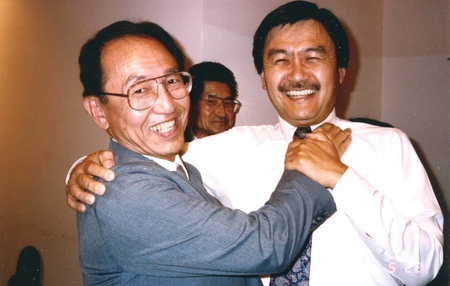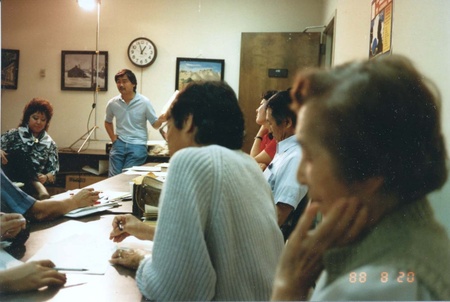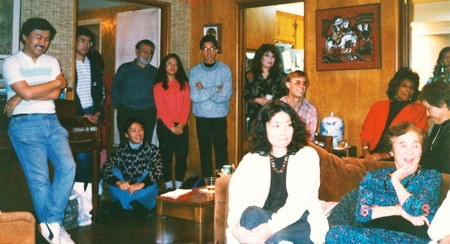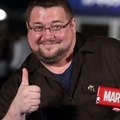The first time I realized Alan Nishio’s health was in decline was on November 19, 2022 when I attended the funeral of beloved NCRR co-founder Jim Matsuoka in Whittier. According to those gathered, Alan had “vowed” he would be there to pay tribute to his colleague, with whom he worked at Cal State Long Beach for some 30 years.
But Alan had suffered a health setback and had to remain at home.
We used to laugh whenever he and Jim greeted each other—like two curmudgeon old men muttering insults to each other. At a party, I once took a picture of them that captured their offbeat relationship, as they pretended to choke each other while laughing. I sometimes joked that they really needed to work out the unresolved sexual tension between them!
I had been an active member of NCRR from December 1984 to February 1993, when the “Falling Down” movie controversy made me realize I could no longer run NCRR’s education committee and Media Action Network For Asian Americans (MANAA)—which we had just started the previous April—at the same time.
We first learned that Alan had been diagnosed with a rare form of cancer in 2006. I reunited with my NCRR colleagues that year on San Pedro Street outside the JACCC for some event and reached out to Alan, concerned about his predicament.
I was surprised by his attitude: He was fine with it.
“Look, I’ve had a great life!” he told me. “I’m going to fight this with everything I have. But there’s no cure, and I know I’m eventually going to die from it. But it’s not like I have a bucket list.” He had achieved everything he’d set out to do.
I told him how much I’d learned from him over the years. For instance, in the 1990s when there was debate on whether or not to allow same-sex couples to marry, I wasn’t quite comfortable with it. But at a party, when I told Alan I was leaning more on the side of tradition, he shot back (perhaps with a bit of annoyance): “It’s not about tradition! It’s about commitment! And if two people are willing to be committed to each other, they should be allowed to get married!”
He made it sound so common sense that I began to reconsider my feelings on the issue. After watching conservative and religious representatives on “Nightline” rationalize hypocritical and outrageous things (e.g., “Everyone knows that the purpose of marriage is to have children, and because same sex couples can’t have children, they should not be allowed to be married!”), I eventually supported the legalization of gay marriages.
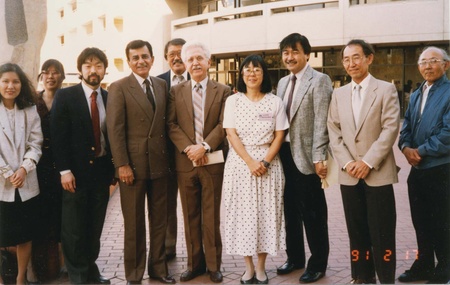
Back in 2006, seeing how down I was about his condition, Alan said, “Don’t worry about me! Hey, I’m gonna go to YOUR funeral!”
“That’s great! I love it!” I laughed. …Wait a minute…!
I’ve often said, the single most important thing I ever did in my life was being one of the 140 people in Washington D.C. who lobbied Congress to pass the redress bill in July 1987. The day before, Alan, as Co-Chair, joined the many dignitaries (e.g., Bob Matsui, Norman Mineta) in giving us a pep talk, and with a smile, led us “into battle.”
In running monthly NCRR meetings, Alan was an effective leader, usually able to reconcile opposing viewpoints by minimalizing the differences between them. But he wasn’t perfect, sometimes wanting to take the easy way out than allowing longer, more contentious debates.
In 1991, a board member relayed to him Frank Emi’s concern about Harold Harada (who’d written nasty things about WWII draft resisters like he): Did Harada need to be on the NCRR panel discussion with the 522nd (who were the first to save the Jews at Dachau)? Alan didn’t want to make waves nor bring the issue up for discussion. Perhaps feeling backed into a corner, he verbally belittled her to the point of tears, leading her to leave NCRR for a few months.
We were passionate volunteers all fighting for a singular cause—redress and reparations—but like many such organizations, it wasn’t always easy to reconcile hard feelings (Later when running MANAA meetings, I always made sure we debated both sides of an issue so everyone felt heard).
At one point, NCRR’s National Spokesperson Bert Nakano told me, “We’re trying to get Alan to run for the Assembly!” But Alan told me he could be more effective as a volunteer than having to get elected to work on issues. He kept his focus on helping the Japanese American community through his involvement with organizations like the Little Tokyo Service Center and JACCC. And we’re the better for it.
Alan also had a great sense of humor. At a social event at his home, in front of a very pregnant Meg Imamoto—who looked on with an innocent, blank look on her face—he joked: “Aki [Maehara] and Meg have been so dedicated to the redress cause that they took a vow of celibacy! They wouldn’t have sex until the bill was passed!” It was one of the funniest things I’d ever heard in my life. I laughed so hard!
In February of last year during NCRR’s annual Day of Remembrance program, I heard that the treatments Alan had been receiving to fight his cancer were no longer working. He was going into hospice care. When celebrities announced that, they sometimes died within a week. I often opened my emails each morning worried about seeing his name in the title of one of them, knowing that sad day had finally come.
I wrote to Alan on March 5th, mentioning many of the memories I’m sharing here and thanking him for his “lifelong devotion to helping our community… You helped our community heal. I’m so glad people like Bert Nakano, who worked so hard to achieve [redress], lived long enough to see that day. For other Asian Americans and even non-Asians, it demonstrated what was possible if we worked hard enough and with a great strategy."
“What I told you then [in 2006] still holds true now: There’s so much more I have to learn from you. I hope I can continue to… If there’s anyone who can turn your condition around, it’s you. You’ve fought this for 17 years?! You are such a warrior. Good luck. And thank you for what you’ve given all of us so far. It’s been an honor knowing and working with you.”
On the 28th, he responded, in part: “You have a great recollection of the many chapters of the R/R campaign. It was a historic movement for which we should all be justly proud. I know that you have continued in your activism in your work with MANAA as I feel that most of us involved in R/R continued in our activism after we experienced the impact that community organizing and grassroots activism can have in changing history."
“I recall our early days when you had graduated from Oxy and working with Casey Kasem. Little did we know at that time how we would be involved in a movement that changed all of our lives!..."
“My journey with cancer included seven abdominal surgeries, four chemo therapies and three radiation treatments. My body has been through a lot and yet these past years have been ones that I have enjoyed and appreciated. My initial diagnosis was two to five years so my battle with my cancer far exceeded expectations and made me appreciate the time that I had to continue doing the things that I enjoyed and believed in. I remain in good spirits as I reflect on a life well-lived, surrounded by a loving family and a wonderful group of friends with whom I have shared experiences at work and in the community."
“This is an unusual time for me as I continue to interact with friends and family, stay up to date on community happenings, get angry over the attacks on democracy occurring world-wide while understanding that I have weeks to live. Thanks for being a part of the network of friends and comrades with whom I have had the opportunity to work with over the years.”
Even though he’d been given only three months to live, Alan kept defying the odds, attending the inaugural Bike Ride For Alan event in April, though unable to receive JACL’s Lifetime Achievement Award in person in July.
I checked in on him again in November. In my last correspondence to him on the 18th, I wrote:
“You're like Jimmy Carter, who went to hospice care 9 months ago & is still alive. I'm sure you're going to beat him.”
I also talked about the new Beatles song “Now and Then” and hope he checked it out, as I later learned his all-time favorite song was John Lennon’s “Imagine.”
Inevitably, the end finally came on December 27.
In the end, Alan Nishio defied expectations every step of the way. Though initially given only two to five years to live, he stretched it to almost 18 years. Just three months to last in hospice care? How about 10?
The doctor had told him he might not even survive his first operation. Yet the night before, he was calm, not nervous at all. Even back in 2006, he was at peace.
It’s those of us who knew and worked with him who’re left heartbroken.
The strength and bravery that Alan Nishio modeled these past 17-18 years serves as a great reminder of how we need to live our lives—without regret nor leaving any dream unfulfilled. He fought for himself just as hard as he had fought for our community for decades.
Even in death, Alan, I am continuing to learn from you.
*This article was originally published in the Rafu Shimpo on February 8, 2024.
@ 2024 Guy Aoki


